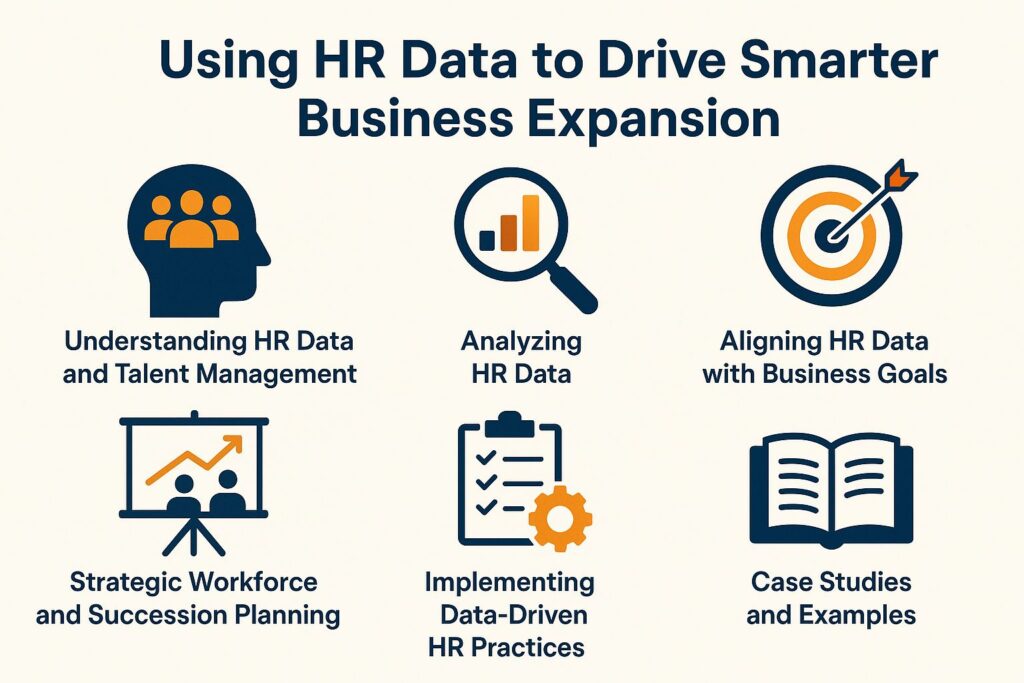
Using HR Data to Drive Smarter Business Expansion
Effectively using HR data can improve your business growth plan with strategic workforce planning. In a field where every decision matters, knowing how to use this data for better operations is important. You’ll look at different types of HR data, find important measurements that help organizations grow, and understand how to match workforce planning with your business objectives. Want to use this tool to learn and make informed decisions? Learn how using data in HR can improve your achievements and help you stand out.
Overview of HR Data and Workforce Analytics
HR data encompasses various metrics that inform workforce analytics, from employee performance to compensation analysis.
Key data points include employee turnover rates, which help identify retention issues, and engagement scores that reflect staff morale and productivity.
For example, monitoring turnover over time helps HR identify patterns and put in place plans to keep employees, like better orientation programs.
Regular employee surveys can help understand job satisfaction, which can lead to specific changes like flexible work schedules or chances for career growth.
By studying these measurements, organizations can build a more involved and effective workforce, which leads to better business results.
**Significance of Decisions Based on Data and Evaluating Risks**
Using data to make decisions helps organizations expand. Companies using analytics tools can improve their performance by as much as 30%.
For example, Google uses People Analytics to evaluate how involved employees are and improve their hiring methods, which has greatly lowered the rate at which employees leave.
IBM’s Talent Insights software assists HR in identifying areas for employee growth and recommends training to improve team skills.
Organizations can start with tools like Tableau for visual data displays or LinkedIn Talent Insights to study workforce data.
This practical information directly influences strategic decisions, aligning HR tasks with business objectives and improving overall results.
HR Data and Talent Management Explained
Knowing the kinds of HR data, where it comes from, and how it is collected is important for good management of employees. This knowledge can be expanded by understanding how data-driven HR strategies, including the selection of the right tools, impact employee management in practical scenarios-our detailed exploration of Data-Driven HR Explained: Benefits, Tools & Real-World Examples highlights these aspects.
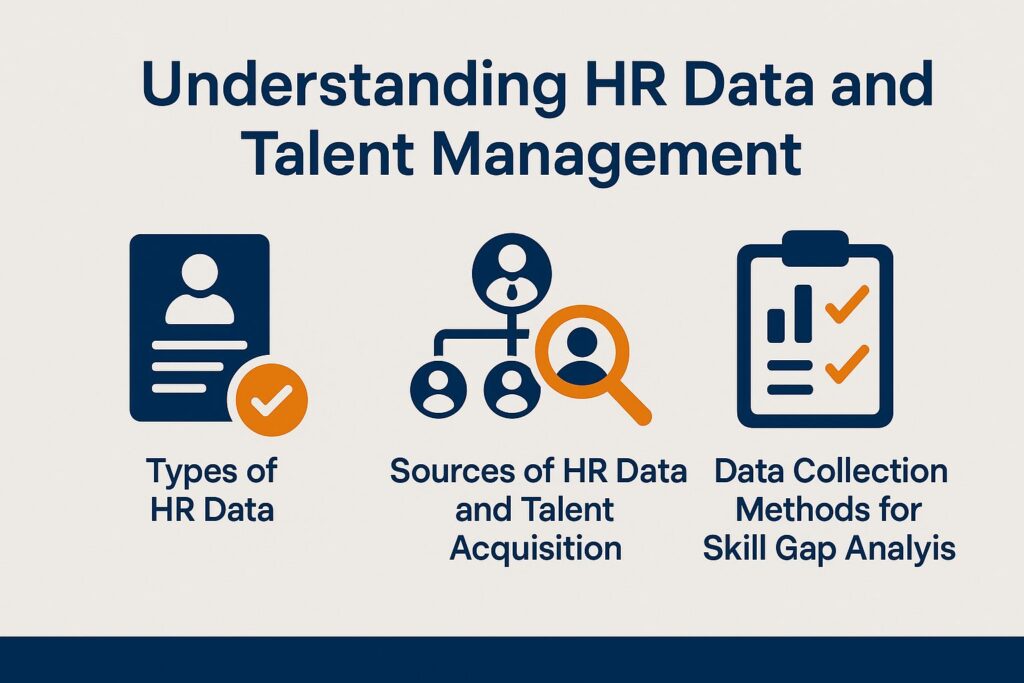
Types of HR Data
Key types of HR data include performance metrics, employee engagement scores, and turnover rates, each serving distinct purposes in workforce management.
Performance metrics, such as productivity rates and goal achievement percentages, help assess individual and team effectiveness.
Employee engagement scores, collected through surveys, help understand morale and job satisfaction, influencing strategies to keep employees.
Turnover rates, calculated by dividing the number of separations by the average number of employees, signal organizational health; a high rate may indicate deeper issues within the workplace culture.
By regularly reviewing these data types, HR professionals can make informed decisions, customize actions, and create a more efficient workplace.
Sources of HR Data and Talent Acquisition
HR data is sourced from internal systems like applicant tracking systems and external databases such as labor market reports.
Internal data sources include Human Resource Information Systems (HRIS), which centralize employee records and performance metrics, enabling better workforce analysis.
Applicant tracking systems (ATS) organize hiring tasks by monitoring where candidates are in the process and where they come from.
Labor market reports help people learn about local job patterns, salaries, and which industries are hiring. For a deeper understanding of how these tools can transform HR practices, consider exploring our insights on data-driven HR.
Putting these pieces of information together can lead to better planning and employee management, ensuring decisions are based on good information and align with company goals and market trends.
Data Collection Methods for Skill Gap Analysis
Effective ways to gather information include surveys, performance reviews, and HR software analytics, each giving important information.
- Surveys using tools like SurveyMonkey or Google Forms can collect employee opinions on job satisfaction and workplace environment.
- For performance reviews, consider tools such as Lattice or 15Five, which facilitate structured feedback and goal tracking.
- HR software like BambooHR or Workday provides analytics that reveal retention rates and hiring trends.
By using these methods together, organizations can gain a complete view of their employees, allowing for decisions based on data that increase involvement and productivity.
Analyzing HR Data
Analyzing HR data requires knowing important measurements and using effective data analysis methods to guide important decisions.

Key Metrics for Business Expansion and Data Visualization
Key metrics such as employee turnover rate and time-to-hire are essential indicators of potential business expansion opportunities.
For instance, an employee turnover rate below 10% is typically indicative of a stable workforce, supporting growth and reducing hiring costs. In contrast, a time-to-hire of less than 30 days often correlates with a strong employer brand and efficient recruitment processes.
To monitor these numbers, use tools like BambooHR for employee turnover rates and Greenhouse or Lever to track the duration of the hiring process. Regularly reviewing these metrics can help HR departments make decisions that match the organization’s overall objectives.
Data Analysis Techniques
Methods such as predictive analytics and regression analysis help turn HR data into useful information for planning strategies.
Predictive analytics can use past turnover rates to estimate staffing requirements for upcoming quarters. Tools like Alteryx or Tableau enable HR teams to visualize and analyze trends effectively.
By employing regression analysis, you can evaluate how factors like employee engagement scores influence retention. This might involve correlating survey data with turnover rates, allowing HR to target areas for improvement.
Using these methods improves efficiency and makes HR an important part of company growth.
Tools for HR Data Analysis and Automation
Effective tools for HR data analysis include Tableau ($70/user/month) and Microsoft Power BI ($9.99/user/month) for visualizing metrics.
While Tableau is ideal for advanced analytics and interactive dashboards, Microsoft Power BI is often praised for its ease of use and integration with Microsoft products.
To choose the right tool, analyze your specific needs: if collaboration and sharing reports are essential, Power BI is excellent. Conversely, for complex data modeling and custom visuals, Tableau shines.
Many companies start with Power BI for its lower cost and scalability, then transition to Tableau as their data needs grow, maximizing overall efficiency in their HR analytics.
Aligning HR Data with Business Goals and Strategic Initiatives
Matching HR data with business goals makes sure HR plans help the organization’s main aims work well (our guide on data-driven HR provides detailed insights on this alignment).
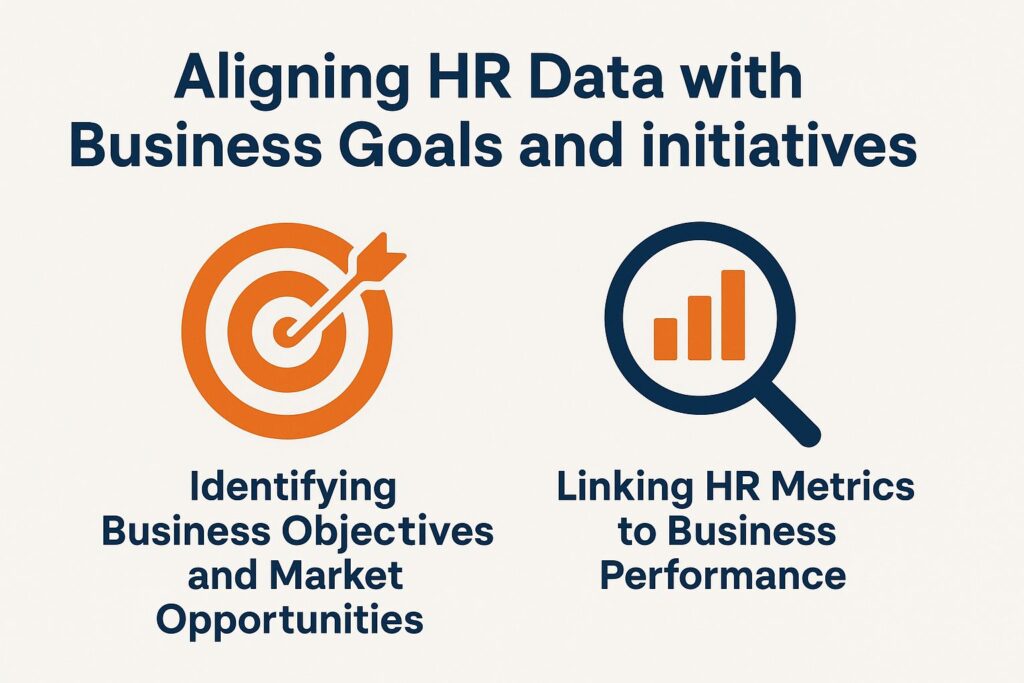
Identifying Business Objectives and Market Opportunities
Setting clear business goals is key for matching HR data strategies with company growth.
- Begin by doing a SWOT analysis to identify your organization’s strengths, weaknesses, opportunities, and threats.
- Next, involve stakeholders in brainstorming sessions to clarify what success looks like, focusing on specific metrics like employee retention rates or productivity measures. For instance, aim for a 10% increase in retention over the next year.
- Tools like the SMART criteria help make goals clearer by ensuring they are Specific, Measurable, Achievable, Relevant, and Time-bound.
- By establishing these clear objectives, HR can create targeted strategies that drive meaningful outcomes.
Linking HR Metrics to Business Performance
Linking HR metrics to business performance enables organizations to quantify the impact of HR initiatives on overall success.
For instance, high employee engagement scores have been shown to correlate with increased sales growth. Companies like Gallup report that businesses with engaged employees experience 21% higher profitability.
To put this into practice, HR can carry out frequent engagement surveys using tools such as Qualtrics or SurveyMonkey. Analyzing the data lets organizations identify areas for improvement, such as offering professional development opportunities or enhancing workplace culture.
By regularly monitoring these metrics, companies can develop specific plans that raise morale and increase revenue and productivity.
Strategic Workforce Planning and Succession Planning
Strategic workforce planning means figuring out what jobs the company will need later and identifying skill gaps, so hiring aligns with the company’s goals.
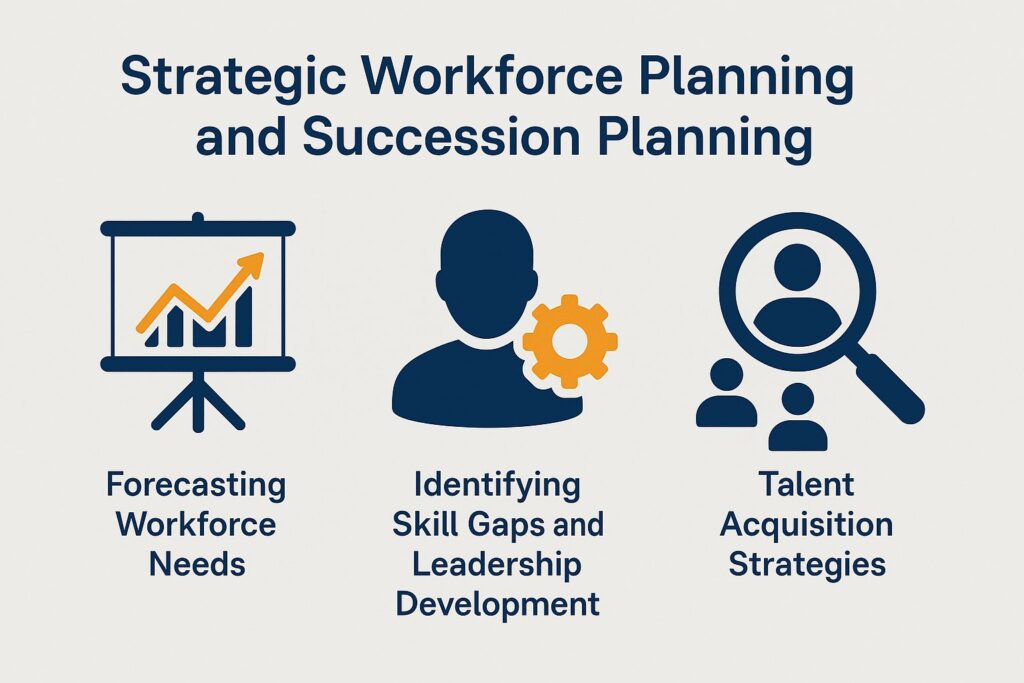
Forecasting Workforce Needs
Figuring out how many staff members are needed helps in planning hiring activities. Using methods like trend analysis gives information about upcoming hiring needs.
One useful method is doing a SWOT analysis on your current staff-looking at strengths, weaknesses, opportunities, and threats. Use past hiring data to find trends in employee departures and recruitment.
Tools like Tableau can visualize these trends, enabling you to predict shifts in workforce demands. Regularly consult labor market reports to understand industry growth forecasts.
By integrating these strategies, businesses can create a proactive hiring plan that aligns with projected market changes, ensuring they attract the right talent at the right time. For those interested in streamlining business operations alongside workforce planning, see also: HR Management | A Guide to Simplify Business Operations.
Identifying Skill Gaps and Leadership Development
Finding areas where employees need improvement allows for focused training programs to improve how they work.
To effectively pinpoint skill gaps, start with employee assessments, utilizing surveys and performance reviews to gather data.
Set up feedback systems where colleagues and managers can share thoughts on a person’s strong points and areas for performance improvement through HR data.
Assess industry norms by reviewing the skills required for similar positions or using resources such as the Competency Model from the U.S. Department of Labor to improve human resources methods.
By thoroughly reviewing this information, leaders can focus on training programs that match the goals of the organization and the growth needs of employees, thereby improving training effectiveness and employee satisfaction.
Talent Acquisition Strategies
Employing recruitment methods and tools informed by data can significantly improve hiring procedures and make recruitment plans better.
For example, using an Applicant Tracking System (ATS) like Greenhouse or Lever makes hiring faster and matches strategic goals.
Greenhouse provides useful tools for reviewing and making the hiring process better with business data, while Lever is good for managing communication with job applicants.
To increase your recruitment efforts and focus on growing your team, consider using tools like LinkedIn Recruiter for focused searches or Hired to find a diverse group of qualified individuals.
By mixing these technologies, companies can improve candidate involvement, shorten the hiring process, and create a more effective recruitment setting through operational analytics.
Implementing Data-Driven HR Practices
Using data-focused HR methods is important for improving how employees are involved and how their work is managed in the current workforce, supporting workforce optimization. This approach aligns with the principles outlined in our analysis of Data-Driven HR Explained: Benefits, Tools & Real-World Examples, ensuring that organizations can effectively harness data to enhance these processes.
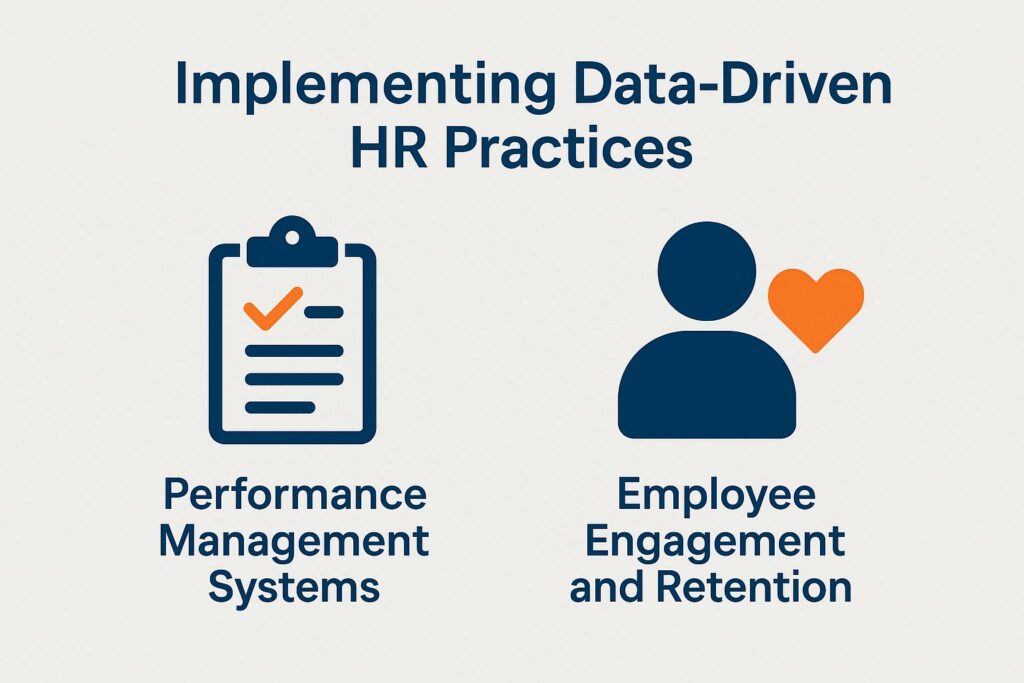
Performance Management Systems
Performance management systems like Lattice and 15Five help organizations monitor how employees are doing and connect their work to business goals to improve company performance and decision-making.
These systems often use ongoing feedback tools, allowing employees to get immediate information about their performance, facilitating performance evaluations.
For instance, using tools like Lattice, managers can set up regular check-ins and feedback requests that directly tie to Key Performance Indicators (KPIs). Companies can create dashboards to display these KPIs, ensuring everyone is aware of their performance.
Creating a regular review schedule, such as every three months, helps adjust goals to address both individual and company requirements. This keeps progress and teamwork in line and encourages a focus on analytics.
Employee Engagement and Retention
Data-driven strategies for improving employee engagement can lead to retention rates increasing by up to 25%, enhancing employee advocacy.
To make use of this opportunity, think about using tools like Officevibe. It provides anonymous surveys to measure how happy employees are and find areas that need betterment, supporting change management.
Regular feedback sessions encourage open communication. Tools like 15Five can help with setting goals and managing performance, increasing involvement by matching personal and company goals, enhancing stakeholder engagement.
Slack is effective for team communication, facilitating teamwork and encouraging the use of collaboration tools.
These methods engage employees and encourage a culture of openness and support, building an inclusive workplace environment.
Case Studies and Examples
Looking at examples of companies that use HR data can show useful information about effective methods and results, aiding market analysis.
Successful Companies Using HR Data
Firms like Google and Netflix use HR data to make better hiring decisions and increase employee effectiveness, resulting in substantial growth, demonstrating effective business strategy.
For example, Google uses thorough data analysis in its hiring process, applying algorithms to compare candidate resumes with profiles of successful employees, greatly enhancing how they recruit through predictive modeling.
Netflix gathers employee opinions to assess performance, matching its focus on high achievement, and offers training programs to improve staff skills.
Both companies demonstrate how data analytics helps with hiring and improving retention strategies, creating a workplace where employees feel appreciated and involved, which leads to strong market benefits and positive business outcomes.
Lessons Learned from Failures
Analyzing failures in HR data application reveals critical lessons, such as the importance of proper data governance and employee feedback mechanisms, highlighting the need for compliance.
A retail company had trouble keeping employees because they used incorrect performance data, which resulted in poor decisions about promotions. They put in place a strong data validation method and held regular feedback meetings with employees, leading to a 25% drop in turnover within a year.
Another example is a tech startup that failed to track remote employee productivity effectively. By adopting tools like 15Five for continuous feedback and Asana for project management, they improved team collaboration and engagement.
These experiences highlight the need for clear data practices and ongoing communication.
About the Author
Ellen Westbrook is a Stanford University graduate with a bachelor’s degree in human resources and psychology. She’s the owner of a successful HR and payroll outsourcing firm in Colorado and a contributing writer for HR Costs. With 17 years of experience, Ellen helps businesses reduce risk, manage HR more efficiently, and grow with confidence.

